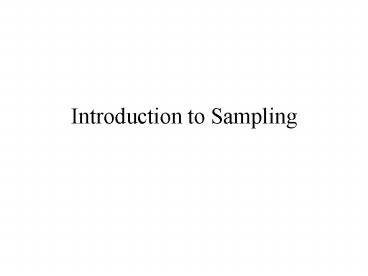Introduction to Sampling - PowerPoint PPT Presentation
1 / 25
Title:
Introduction to Sampling
Description:
... distribution of estimates of a parameter over a large number of samples. ... value, squaring the differences and averaging them, and taking the square root. ... – PowerPoint PPT presentation
Number of Views:23
Avg rating:3.0/5.0
Title: Introduction to Sampling
1
Introduction to Sampling
2
Objectives
- Understand reasons for sampling
- Know kinds of samples
- Characteristics
- Uses
- Strengths and weaknesses
- Mechanics of sample selection
- Determining size
- Process of selection
- Implications of sample for analysis
3
Why Sample
- Cost or cost effectiveness
- Tradeoff between quantity and quality of data
- Lack of availability of population
4
Terminology
- unit of analysis or element-unit about which
information is collected and the basis of
analysis. - population-all elements or units to which
explanation, descriptions are meant to apply. - survey population-elements actually sampled.
5
- sampling unit-element picked in samples. May be
same as unit of analysis, but not necessarily
(e.g. cluster samples). - sampling frame-list from which sample picked.
May be same as survey population, but not
necessarily (as above) - observation units-element from which data
collected. Usually same as sampling units, but
not necessarily (e.g. data on congress. offices
collected from sample of AAs).
6
- variable-a measure of some characteristic (e.g.
how much a person makes). - Statistic-a summary of a variable for a group.
(e.g. mean or median income for people in the
sample.) Varies with the sample selected - parameter-a statistic for a population. Constant.
7
- Sample Design-procedures for selecting units from
the population for the sample. - Sampling Fraction-percent of the population
selected for the sample
8
Types of Samples
- Almost all samples are combinations of types.
- Probability-Sample selected so that there is a
known probability of selection for all units in
the population. - Non-probability-Probabilities are not known.
9
Non-Probability
- Convenience-selection driven by availability of
units. - Purposive-selection based on need to observe
units with specific characteristics. - Quota-units selected so that predetermined number
of specified types of units are selected. - Snowball or referral-respondents nominated by
other respondents.
10
Non-probability Considerations
- Cannot calculate error due to sampling
- Typically less expensive
- May be only practical alternative
- Convenience
- Least costly
- Most susceptible to unrepresentativeness
- Purposive
- Insures that required diversity is present
- Not necessarily related to population
11
- Quota
- Requires identifiable characteristic
- Makes sample representative of quota
characteristic - Snowball
- Useful to find small populations when there is
connection between members - May/likely to introduce factors making sample
non-representative
12
Probability
- Simple random sample-randomly select units in
population. - Systematic sample-sample every nth unit from a
list (periodicity an issue). - Stratified sample-samples drawn separately within
separate strata of the population. - Multistage/Cluster sample-sample clusters of
units and then sample within clusters.
13
Types of Stratified Samples
- Proportionate- percent of sample drawn from each
strata equals percent of the population in the
strata. - Disproportionate-some strata are sampled at a
higher rate so that a different proportion exists
in the sample than in the population. Useful for
obtaining sufficient number of smaller
strata/groups.
14
Reasons to Stratify Sample
- Efficient sample when groups of interest are
small. - Reduction in error due to sampling.
15
Probability Sample Considerations
- Simple random sample
- requires inventory of units and practical way of
getting to each one - predictable error
- not subject to factors making unrepresentative
- Systematic sample
- requires units that are inventoried and ordered
- generally good as or better than SRS
- susceptible to error due to periodicity
16
- Stratified Random-
- Similar to quota, except random sample in each
strata - Must have characteristic identifiable before
sample is selected - Allows for control of representativeness of
strata - Allows for efficient representation of small
strata
17
- Multistage cluster
- Good where individuals not identifiable from an
inventory - Error can be calculated
- Error will almost always be higher.
18
Other Sampling
- Experiments
- Focus Groups
- Threshold (Quality control)
19
More Terminology
- sampling distribution-distribution of estimates
of a parameter over a large number of samples. - standard deviation-a measure of the degree of
variability of a set of values calculated by
calculating the mean and differences between the
mean and each value, squaring the differences and
averaging them, and taking the square root.
20
- standard error-measurement of the expected error
due to sampling. It is the standard deviation of
the values for a parameter obtained from an
infinite number of samples. - confidence level-probability of a specified error
due to sampling.
21
- confidence interval-the interval around a
parameter for a sample in which the population
parameter will be found with a specified level of
confidence (z_score). - sampling bias-the difference in the average
values of parameters from an infinite number of
samples and the population parameter. - Power-ability to correctly determine that a
relationship in a population exists based on a
sample.
22
Sampling error refers only to error expected from
random selection!!
- Not...
- - Error due to population sample frame
discrepancy/non-representativeness - - Error due to non-response
- - Measurement error
23
Factors Affecting Sample Size
- The accuracy needed
- Confidence level
- The variability of what is being measured
- The size of subgroups to be analyzed
- Not usually--size of the population
24
Sample Size Calculation for Simple Random Sample
and Estimation of Population Proportion
25
Implications of Sample Design for Analysis
- Stratified samples require weights.
- Knowledge of population
- Standard error estimation more complicated if not
simple random sample. - Stratified samples
- Cluster samples































